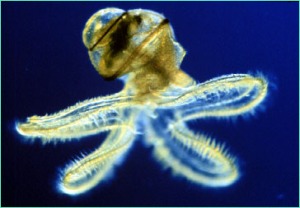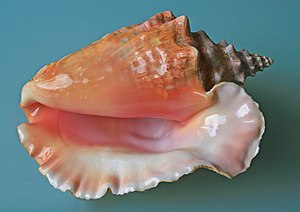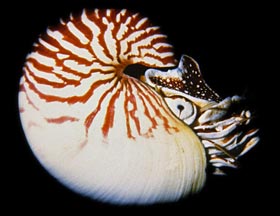Xiphosura is the order of the Atlantic horseshoe crab and its three closest living related species.
It’s as easy as A, B, Sea: V for Veliger
It’s as easy as A, B, Sea: Q for Queen Conch
Queen conch (Strombus gigas) is a marine snail or gastropod. If you’ve ever eaten conch fritters you understand why conch is a staple food source in the Caribbean and Florida.
The shell of a queen conch thickens and grows as it ages. They get to be about 3-5 years of age and grow up to 12 inches long.
Learn more about the queen conch here.
It’s as easy as A, B, Sea: N for Nematocyst
Nematocysts are the stinging cells found in the tentacles of jellies and anemones. When provoked the stinging cell ejects a barbed thread that contains a toxin to stun (or kill) the enemy. The barbed thread is disregarded and a new one regenerates.
Here is a creative video explaining how jellies sting from jellyfishart.com. Enjoy!
It’s as easy as A, B, Sea: L for Limpet
 Limpets are small, flattened snails with a conical shell that live on rocks in the intertidal zone. They trap water beneath their shell and use it to survive from high tide to low tide.
Limpets are small, flattened snails with a conical shell that live on rocks in the intertidal zone. They trap water beneath their shell and use it to survive from high tide to low tide.
Image (c) wordsmith.org
It’s as easy as A, B, Sea: H for Horseshoe Crab
Horseshoe crabs are an arthropod more closely related to spiders and scorpions than crabs and lobsters. They have a three part body: prosoma (head), opisthosoma (heavy shell with legs under it) and the telson (tail). This amazing body structure has been unchanged for over 200 million years. Interestingly enough, this is this Beach Chair Scientist’s favorite animal and there have been numerous posts about Limulus polyphemus. Read more here.
It’s as easy as A, B, Sea: C for Chitin
Chitin (kai-tin) is the main material for 1) the exoskeleton of shrimp, crabs and lobsters, 2) the beak of squid and octopi and 3) the radula of mollusks. It is very similar in make up to glucose and similar in function to keratin (which is what makes up our hair, skin and nails).
Happy as a clam
Lately everyone has been asking me how the junior Beach Chair Scientist is doing and I often find myself saying, “Oh! She’s as happy as a clam!” It occurred to me that I didn’t fully understand the expression since clams are not known to smile. I did some research and found out that the phrase originates from parts of New England where clams are a plenty. Also, the phrase is better understood in its entirety, “Happy as a clam at high water.” You see, at high tide clams can avoid there predators in the water so they are quite happy indeed! So next time someone says they are “happy as a clam” you can say … “did you know?” cause everyone loves that kind of person, right?
Image (c) civin.org
What is the mystery of the chambered nautilus?
“Year after year beheld the silent toil
That spread his lustrous coil;
Still, as the spiral grew,
He left the past year’s dwelling for the new,
Stole with soft step its shining archway through,
Built up its idle door,
Stretched in his last-found home, and knew the old no more.”
Oliver Wendell Holmes (1804-1894)
The above is only an excerpt from the poem, “The Chambered Nautilus” by Holmes published in 1858. It only begins to hint at the marvel of this magnificent cephalopod. The chambered nautilus has become breathtaking subject matter for generations of artists and has become a commodity on the commercial trade industry.
The chambered nautilus is a squid that lives inside a shell marked with a brown and white zebra pattern. As the squid grows, the shell grows with it and creates compartments which are used as gas chambers and help the cephalopod rise or sink in the water column. The inside of the shell is lined with an iridescent pearl. In the last chamber of the shell are almost 90 tentacles and large eye peering out. Predators of the chambered nautilus include sharks, turtles, and octopus.
What makes the chambered nautilus so mysterious and sought after? Is it the mother of pearl that lines the inside of the animal’s shell? Is it that the animal represents a far off species only found tropical Indo-Pacific? Or is it that the inside compartments of the chambered nautilus each mirror its smaller and larger part exactly and therefore the animal is an example of the golden rectangle found in nature.
This harmonic progression is an illustration of Fibonacci’s sequence. This is a sequence where the first two numbers in the series are added to create the third number for a series of number that begins 0, 1, 1, 2, 3, 5, 8, 13, 21, 34 and so on forever. This proportional pattern can be seen all over in nature: flower petals, pine cones, and even galaxies. Below is an illustration of the proportion as it relates to the chambered nautilus.
Image (c) top – seasky.org, bottom – http://2muchfun.info
Do you have another interesting question? E-mail info@beachchairscientist.com and let us know what you always ponder while digging your toes in the sand!
Reference Squid
I would love to share this wonderful squid dissection video from Paul Dewiler, Instructor of Marine Science at the San Diego Mesa College. The video was inspired by his overview during his Ultimate Squid Dissection workshop at the National Marine Educators Associations 2010 conference in Gaitlinburg, TN. He states that the purpose of the video is to, “illustrate the squid’s external and internal anatomical structures so that teachers are confident and able to lead and assist their students in dissecting this species in the classroom”. As someone that has struggled with and watched other struggle with the dissection of a squid I am excited to share this wonderful resource. Thank you, Paul!












What people are saying …